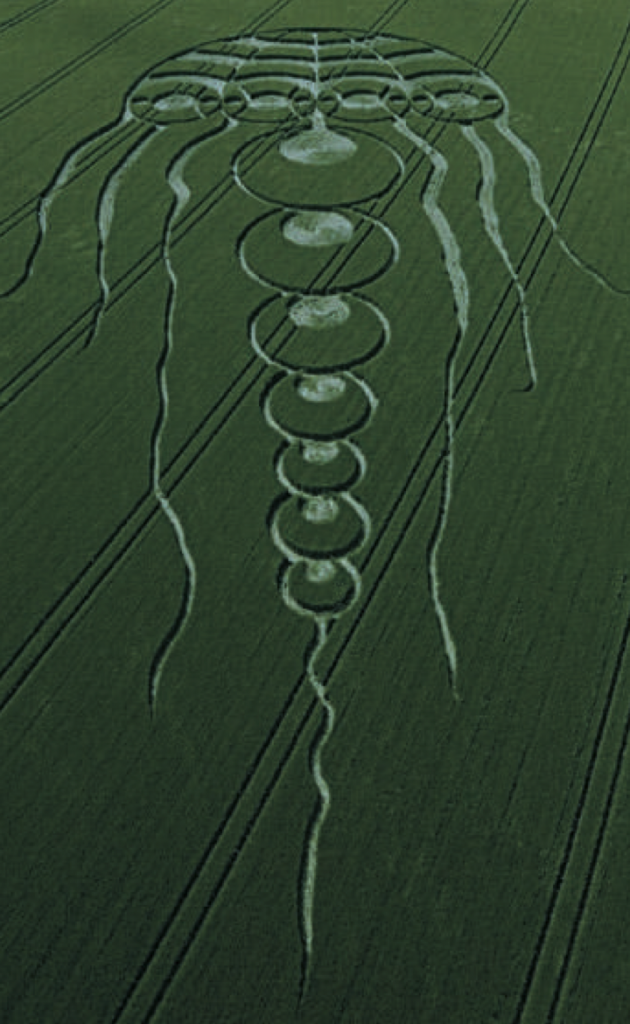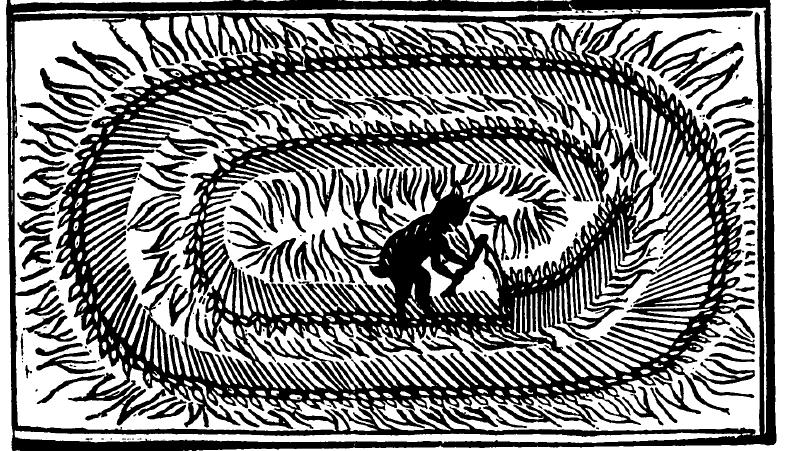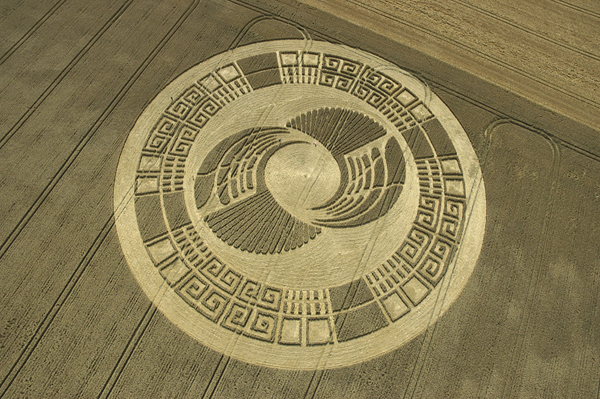A scientist colleague of mine, who is famous and doesn’t want an association with crop circles to be made known in orthodox scientific circles, sent me a piece published recently in Nature, which is a very prestigious scientific journal out of England. Just as that Yahoo video was shockingly irresponsible, so is this. You can’t link to it online cause you have to be subscribe to Nature
to do that, so I am bringing it to you in its entirety. Here it is:
The crop circle evolves
Last summer, a 180-metre-long jellyfish surfaced in a barley field in Oxfordshire, UK. How it got there is unclear, but microwave radiation, Global Positioning System receivers and lasers have come under suspicion. This ‘crop circle’ was sculpted from countless stalks that were bent and oriented in ingenious ways.
Bewildering the British since the 1600s, the crop-circle phenomenon has spread to Europe, Russia, North America, Japan and India. The complexity of the designs — many of which have a mathematical basis — has escalated in the past two decades, reflecting a serious and science-literate artistic movement. A bumper crop of patterns is anticipated as the summer kicks off in the Northern Hemisphere.
The first formal scientific comment on crop circles was published in Nature in July 1880 by John Capron, who speculated that the “circular spots” were induced by cyclonic winds (J. R. Capron, Nature 22, 290–291; 1880). A century later, meteorologist Terence Meaden, then at Dalhousie University in Halifax, Canada, refined Capron’s theory to explain more recent crop-circle appearances across southern England. He proposed in 1980 that the airflows induced by local hillsides stabilized the position of whirlwinds long enough to carve the circles.
There was a simpler explanation. Four years earlier, artists Douglas Bower and David Chorley began creating a series of circles in Hampshire’s barley and wheat fields after reading old news reports about a pattern imprinted on Australian marshlands, supposedly by a UFO. Their hopes of initiating a UFO hoax were frustrated by the interest in Meaden’s whirlwind theory. A battle of wits ensued.
Bower and Chorley increased the complexity of their patterns to show that they were not manifestations of the weather. But Meaden adapted his whirlwind theory accordingly: his electromagnetic–hydrodynamic “plasma vortex” explained the multi-circle designs as well as the dead tractor batteries and eerie lights that seemed to accompany their formation. The artists countered by including straight lines in a pictograph consisting of two circles and five rectangles. This convincingly ruled out natural causes, and represented an artistic leap. After ten years of competition, in 1991 the two announced their hoax to the press.
A second wave of crop artists then emerged, cultivating hundreds of increasingly sophisticated pictographs that have appeared annually around the globe. Mathematics is central to the modern designs, which incorporate symbols and fundamental constants such as ? — the ‘golden ratio’ — and ?, sometimes to an accuracy of ten digits. Thanks to increased computing power, iterative equations are used to generate shapes that repeat across many scales. Pictographs today can measure 300 metres across and can comprise up to 2,000 elements.

S. ALEXANDER
The jellyfish of bent barley in Oxfordshire last year.
The designs often integrate Euclidean shapes with fractal icons such as Koch curves and Mandelbrot sets. Over the past five years, such complexity has driven the emerging organic movement, which embeds the mathematical patterns within boundaries that are reminiscent of nature’s forms. This cumulated last year in representations of trilobites, dragonflies, caterpillars, birds and the jellyfish pictured. The seven circles in the jellyfish’s ‘tail’ demonstrate precision scaling and its head displays classic symmetry. The free-form tentacles add the organic quality.
As in all art movements, crop-circle artists follow rules laid down by their founders. Respecting the Bower–Chorley tradition, many create their pictographs anonymously during the short midsummer nights, leaving the scene free of human traces. Their challenge lies in creating the escalating designs within these cultural constraints. Modern construction methods have helped: today’s patterns are mapped out using computers, laser pointers and satellite equipment, and artists work in coordinated teams. Bower once used only a crude sight, consisting of a circular wire dangling from his cap, to guide his lines. Other traditionalists used wooden planks, string and garden rollers. Artists even used bar stools to vault over regions of undisturbed crop. But there are signs that modern techniques are reaching their limits: in 2009, for the first time, one pictograph was created over three nights, potentially compromising the secrecy tenet.
The time-consuming process of imprinting the patterns is slowed by the insistence that crop stalks be flattened rather than broken. Stalk orientation may vary between different parts of one pictograph, and weaving is used to create multiple layers with shadowy textures that change as the stalks move in response to the Sun.
Artists will seek faster methods to maintain the movement’s evolution. Intriguingly, biophysicists who investigated 250 recent pictographs found that the knuckle-like joints of bent stalks were longer than those on untouched stalks from the same field. The observed elongation and swelling of these joints has been replicated using microwaves to superheat the stalks, causing them to fall over. Some patterns may have been sculpted using microwave generators, such as masers or magnetrons from microwave ovens.
The covert nature of the crop-circle movement fuels a cat-and-mouse game between artist and researcher. To appreciate a pictograph’s intricacy, one must take to the air, sometimes photographing a pattern only minutes before it falls under the blades of a harvester. Each season’s designs are published in a catalogue and their artistic evolution is discussed by dedicated societies. The good news is that these modern mathematical artworks may soon be exhibited in a field near you.
Richard Taylor is professor of physics, psychology and art in the Department of Physics at the University of Oregon, Eugene, Oregon 97403, USA. rpt@uoregon.edu
I can’t get my response into Nature, since I’m no a subscriber to this pricey publication. I’ve emailed the author asking if he would submit this:
Response to “The crop circle evolves” Nature 465, 693 (10 June 2010) | doi:10.1038/465693a; Published online 9 June 2010
Producer/Director
What On Earth? Inside the Crop Circle Mystery
Oh dear. Your story about a mystery that’s stumping the world, presented as coming from “a second wave of crop artists,” bypasses giving any information about how these perpetrations in crop fields get there. In ascribing the delivery to people in “a serious and science-literate artistic movement,” blessings on the “serious and science-literate” part, but “artistic movement?” To baldly state that the glyphs come from human artists ignores elements that indicate they cannot be done by people. For peer-reviewed papers in science journals that attest to that, see https://BLTResearch.com. That this a “a giant art movement” is a fiction of the author’s that was astonishing to find in your science journal.
It’s almost humorous. That the protocols of these artists include “the insistence that crop stalks be flattened rather than broken,” overlooks the fact that it never has been demonstrated that anybody can accomplish that feat. It’s a sort of ‘when did you stop beating you wife’ parallel. It takes a false premise and uses that as the given.
Really, it does get ludicrous, more something for The Onion than for Nature. Where in the fields might those microwave ovens be, into which all the growing stalks are placed to get “The observed elongation and swelling of these joints [which] has been replicated using microwaves to superheat the stalks, causing them to fall over”? Right on that it seems to be microwave energy creating the bends and elongations, but how it is harnessed and administered is beyond anybody’s capacity to explain. What might it have looked like in, for instance, the giant Milk Hill formation of 2001 (in America we describe it as the size of two football fields), during the four hours of darkness when the artist were administering the bending rays? How microwave energy bends those plants into right angles (and we have examples in young pine trees with 3″ thick trunks, just to help boggle minds that should be boggled) is a mystery, and the indication that people aren’t making all of the formations.
Even beyond its false premises, the article plays fast and loose with the facts. “…in 2009, for the first time, one pictograph was created over three nights” is one example of the lack of fact-checking that characterizes it. Here’s a formation from 2004 that came in over three nights. It was a heat wave in which thousands died across Europe, and we were traipsing around in a wheat field, buzzing because it was the first three-day construction.
The sorriest thing is that you are shooting holes in a balloon that could take us somewhere. With billions of stars in our galaxy and the possibility of trillions of galaxies, the likeliest possibility is that we are not alone. Were that to be an established fact, which could result from serious attention to the circle phenomenon, it would humble us and make us one humanity in relation to other intelligent life, results that only could serve our betterment. And, if we started collectively wondering what’s going on in our fields, the circlemakers from elsewhere, who would have to be more advanced technologically that we are, might be able to deliver help they would be hard pressed to give us if we were not receptive to them.
The circlemakers are landing formations near ancient artifacts all over the world, conceivably to remind us of an an earlier time when we felt ourselves to be part of nature. Given that a sense of belonging to the universe and to each other is what we lack in our dog eat dog materialistic world, they could be calling us to what, as someone in my movie says, “could be what saves this civilization.”
How about a follow-up? What the circles could be would make for an uplifting story.

 Follow
Follow










